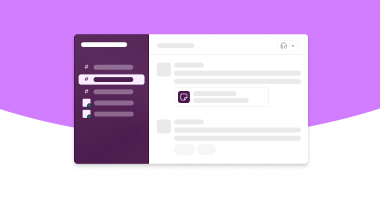OpenAI is an AI research and deployment company that’s revolutionizing how the world perceives artificial intelligence. They’re the creators behind the wildly popular ChatGPT, a versatile AI chatbot that can, amongst many things, compose content and answer questions in a conversational manner.
ChatGPT was released in November 2022 and quickly became a global sensation that millions use every day to work more efficiently.
Throughout this influx of customers and growth to their business, OpenAI has relied on Slack for their collaboration needs. Slack has become the intelligent productivity platform for OpenAI — a place where they can communicate securely with customers, accelerate projects and further their mission of ensuring that artificial intelligence benefits all of humanity.
Using Slack Connect to collaborate directly with customers
Slack Connect allows OpenAI to move conversations with customers out of over-stuffed inboxes and into interactive channels. The company has over 170 Slack Connect channels and has sent over five million messages since becoming a Slack customer in 2018.
Collaborating within channels empowers OpenAI to find faster, more accurate solutions for customer needs.
“Slack Connect is a huge part of our customer experience,” says Anna Tifft, Account Manager at OpenAI. “ What I love about working in Slack is it removes me as a bottleneck. It gives me the ability to bring in my colleagues when a customer has a question that is outside of my purview, or I think someone else can answer more effectively or more quickly than I can.”
In addition to Slack, OpenAI is exploring using other Salesforce products to improve the customer experience. Integrating data from Service Cloud and Sales Cloud into Slack would allow OpenAI to access a 360-degree view of the customer right where they’re working.
“Working with Salesforce and having all of my customer data in one place is huge,” Tifft says. “I’m constantly transitioning between different conversations as I’m moving things forward for my customers. And if I were operating each of those things within a different ecosystem, it would be untenable. So it’s critical that I’m able to execute most of the needs of my customers within one holistic environment with Salesforce.”

Strengthening relationships with internal team members and building company culture
As OpenAI continues to grow, it’s important for them to maintain a strong and connected employee culture. Since they have employees across time zones, it’s also essential for them to have asynchronous ways to work.
“Slack really helps with being able to feel connected to anyone in the organization,” Boris Power, Principle Research Engineer says. “I don’t want to overwhelm people with too many meetings, so anything that can be done asynchronously is best done through Slack. Slack’s also a way to involve a fluid amount of people in a conversation. You can easily add people onto threads or channels who need to maybe give additional input.”
The OpenAI team uses Slack huddles to collaborate quickly and further eliminate the need for meetings. Huddles are a way to communicate through audio or video within a Slack channel or direct message. Anyone in a channel can come and go as they please within a huddle. They can also share their screen to add more visuals to the conversation.
Emojis are another way the OpenAI team communicates within Slack. Emojis allow team members to say things without starting a new thread. Emojis can indicate that messages have been read, that work on a project is in progress or simply encourage coworkers for a job well done.
“I love the emoji reactions. We have a bunch of custom emoji within our company. They’re really fun. They are like a lightweight way to just bring some joy into the day,” says Simón Posada Fishman, a solutions engineer at OpenAI.
OpenAI also uses reaction emoji to collect feedback on its models. For example, someone can add a Slackbot to a channel and ask internal teams or customers to use the “thumbs up” and “thumbs down” emoji to provide feedback. This allows the model to learn and improve over time in response.
In addition to collecting feedback at scale, the OpenAI team uses the Slack platform to find creative ways to automate work. “I think it’s fun to build things within Slack,” Posada Fishman says. “A lot of capabilities come out-of-the-box, and it was way easier than I expected it to be.” The team sees this as a powerful tool for innovation and productivity. “Being able to leverage a chat interface where all of your coworkers are already and bring any sort of automation, intelligence or programmatic abilities directly into where they work is really exciting.”
Another part of what makes the OpenAI team feel confident using Slack to power their work is Slack’s security features. OpenAI uses Slack’s Enterprise Grid for its message retention and admin control capabilities. Enterprise Grid includes Slack’s most robust security features, like data encryption, SAML-based single sign-on and granular app management.
A vision for amplifying the power of AI and automation
As the partnership between OpenAI, Salesforce and Slack progresses, the focus will soon turn to developing innovative solutions and integrations. “I believe there are a lot of possibilities for partnership and integrations between OpenAI and Slack in the future,” Power says. “I believe that improving the workflow and interconnectedness of our organizations is key toward boosting productivity, and that any integration will have a significant impact across all industries using Slack.”
“We at OpenAI use Slack every day, and it is critical to how we get work done here,” says Brad Lightcap, the chief operating officer of OpenAI. “Our company is arguably powered by Slack. The idea of marrying this ability and the power that our models have to help us improve the way we collaborate, to help us navigate information better, to understand things better—that is really powerful.” Combining the capabilities of OpenAI’s robust large language model with Slack and Salesforce could dramatically improve workplace automation and efficiency.














